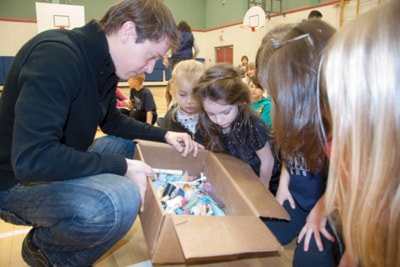A Penticton elementary school has made changes to its hot lunch program that is not only reducing the amount of styrofoam and plastic waste they are creating, but saving them money over the long term.
Local filmmaker Jan Vozenilek calls it a fantastic success story. Last year, he said, the daily hot lunch program at Queen’s Park Elementary consisted of almost 200 kids using all disposable styrofoam plates and utensils for their lunches.
“This was every day, three full garbage bins of waste,” said Vozenilek, who showed a video of the 200 kids dumping their plates into the garbage to the Okanagan Skaha board of education, shot when he did a presentation there.
“I guess they got the point and they funded Queen’s Park over $1,000 to buy stainless steel plates and cutlery. They called it a pilot project,” he said. “Today, all of this is washed in the dishwasher and there is no waste.”
According to Rob Zoppi, principal of the school, they were spending almost $800 a year on the styrofoam plates.
“I didn’t know anything happened at the school until I talked to the principal,” said Vozenilek. “It’s just a small little step, but what if every school in the district did that? What if every school in the province did that? It doesn’t take much.”
Queen’s Park was one of the schools that Vozenilek has brought his presentation to, using his work documenting the plight of albatrosses nesting on Midway Island in the Pacific. Ocean currents drive masses of floating plastic garbage to the area and, mistaking it for food, the birds scoop it up to both feed on it and feed to their young. With bellies filled with plastic, the birds are dying by the hundreds.
Using his films along with images of the birds, their rotting carcasses exposing the plastic inside as a starting point, Vozenilek traces the path of the plastic back to its starting point.
“That’s really the full circle that I now try to paint in these little talks that I do. I work it back with the river system and bring it right back here,” he said. “We talk about walking along the shores of our own lake here on the beaches of Penticton, or the channel, and you find the same kind of garbage on the shores of our lake as you find out on Midway.”
Vozenilek shows the students what they experienced on Midway, then focuses on solutions locally and what various school groups have already done, attempting to inspire them that they could do the same.
“We’re just as responsible here to have an impact on the environment globally,” he said. “The kids just get it. It’s a really simple thing for them. They look at the problem and they instantly jump to the solution.”
